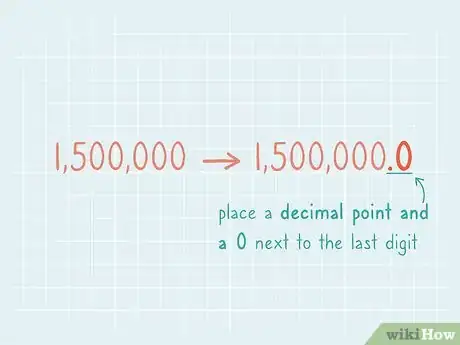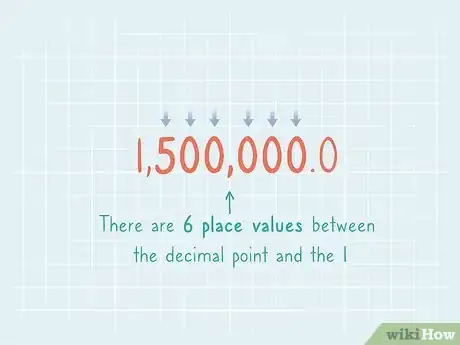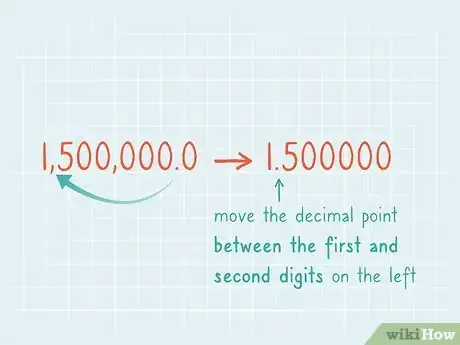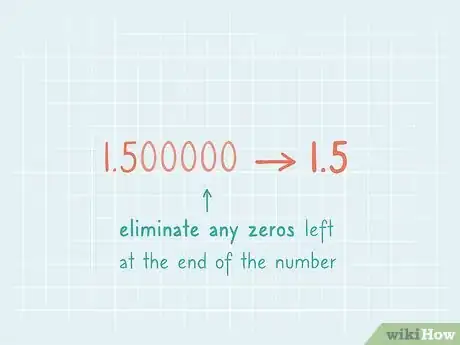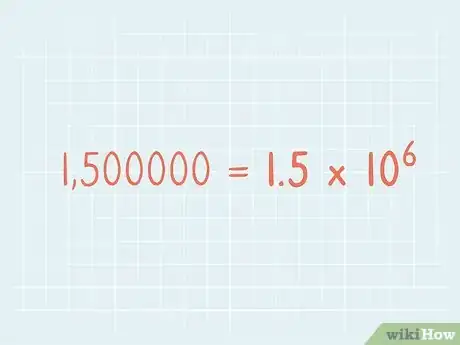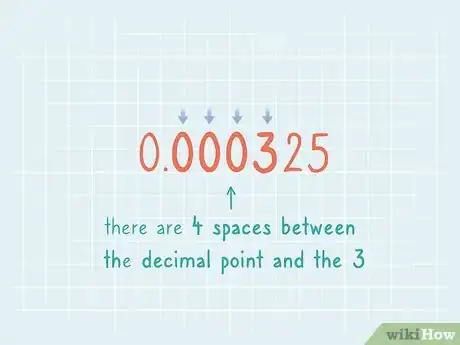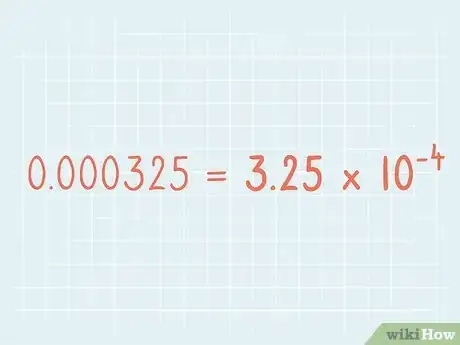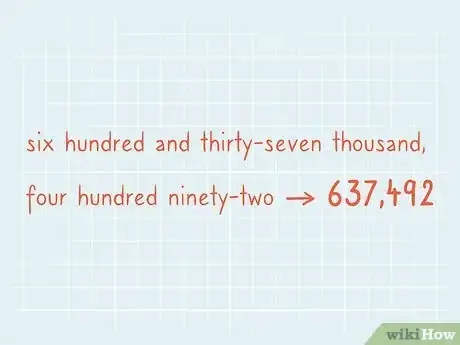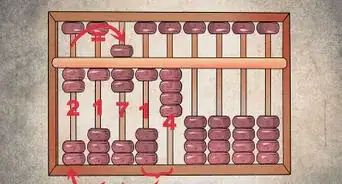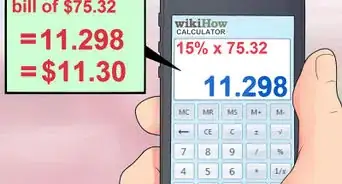This article was co-authored by wikiHow Staff. Our trained team of editors and researchers validate articles for accuracy and comprehensiveness. wikiHow's Content Management Team carefully monitors the work from our editorial staff to ensure that each article is backed by trusted research and meets our high quality standards.
There are 8 references cited in this article, which can be found at the bottom of the page.
This article has been viewed 141,164 times.
Learn more...
Standard form, also known as scientific notation in the US, is a method of expressing very large or very small numbers. It's used in science and math as shorthand, rather than writing out the full number every time you use it. This form also makes doing calculations much easier than working with a number that could have multiple place values. If you handle numbers with many digits, either very large or very small ones, then converting them to standard form by following this process will help.
Steps
Writing Large Numbers
-
1Place a decimal point and a 0 next to the last digit of a whole number. All whole numbers have an implied “.0” at the end. Rather than trying to visualize this, write it out. Place the decimal point to the right of the last digit, then add a 0 after it.
- If the original number was 1,500,000, then write it was 1,500,000.0.
- If the number is already a decimal, like 1,200,000.325, skip this step. For the next step, count from the decimal point that’s already there.
-
2Count the place values between the decimal point and the last digit on the left. For an easy counting method, place your pencil on the decimal point. Then move it left and stop at every space between the numbers. Count each space until you reach the first digit in the number.[1]
- Since the original number is 1,500,000.0, count until you reach the 1. There are 6 place values between the decimal point and the 1.
- Remember the amount of values you counted. This is important later on.
- This also works without zeroes. For 657,799,596.0, there are 8 place values between the decimal point and the 6.
- The first few place values are ones, tens, hundreds, thousands, ten thousands, hundred thousands, and millions. The place values continue rising as numbers get bigger.
Advertisement -
3Move the decimal point between the first and second digits on the left. Once you reach the space between the first and second digits, stop counting. Add a decimal point here and erase the original decimal point.[2]
- The number 1,500,000.0 changes to 1.500000.
- Do the same action if the second digit is a zero. For instance, 5,000,000 becomes 5.000000.
- If the decimal point was printed on the page and you can’t erase it, put a line through it so you remember it’s been moved.
-
4Eliminate any zeros left at the end of the number. If the number ends with 1 or more zeros, then you can ignore them. Either erase them or write the number again with the zeros omitted.[3]
- After eliminating the extra zeros, 1.500000 becomes 1.5.
- Only get rid of zeros at the end of the number. If the number is 8.100200, only get rid of the last 2 zeros so the number is 8.1002.
-
5Write 10 raised to the power of the spaces between the decimal points. This is where the place values you counted are important. First write the number 10. Then add an exponent equal to the number of place values you counted between the decimal points.[4]
- Since there are 6 place values between the decimal points in 1.5 (1,500,000), the exponent is 106.
- In standard form, the number with an exponent is always 10, never a different number.
-
6Express the equation as the number multiplied by 10 and its exponent. Place the number that you converted first. Then add a multiplication symbol, followed by 10 and the exponent. This represents a number in standard form.[5]
- For the original number, 1,500,000, the standard form is 1.5 x 106.
Expressing Very Small Numbers
-
1Count the place values between the decimal point and the first non-zero digit. Standard form also works in the opposite direction to express very small numbers. Rather than moving right to left, move left to right. Place your pencil on the decimal point. Then count the amount of place values between the decimal and the first non-zero digit.[6]
- If the original number is 0.000325, count the place values between the decimal point and the 3. There are 4 spaces.
- There shouldn’t be zeros at the end of a decimal. If there are, erase or cross them out before counting the spaces.
-
2Move the decimal point to the right of the first non-zero digit. Once you’ve counted the spaces, place a decimal point after the first non-zero digit. Erase or cross out the original decimal point so your know it moved.[7]
- If the original number is 0.000325, move the decimal point and eliminate the zeros so it’s 3.25.
- If there are zeros between 2 non-zero digits, keep them. For .034002, write 3.4002.
-
3Write 10 raised to the power of the spaces between the decimal points. This step is the same as when you convert a large number to standard form. First write 10. Then take the number of spaces you counted between the 2 decimal points and write it as an exponent.[8]
- If the original number was 0.000325 and there are 4 spaces between the decimal points, write 104.
-
4Make the exponent negative. For small numbers, the exponent must be negative to indicate which direction the decimal point moved. Simply add a negative sign to the exponent to negate it.[9]
- The original exponent, 104, becomes 10-4.
-
5Express the equation as the number multiplied by 10 and the negative exponent. For the final step, put the equation together. Write the number first. Then add a multiplication sign and the 10 plus the negative exponent after. This expresses the number in standard form.[10]
- For the final result, 0.000325 becomes 3.25 x 10-4 in standard form.
Converting Numbers from Written Form
-
1Convert each individual part of the number to numerical form. Sometimes numbers are written out, making conversion to standard form tricky. In this case, convert the number to numerical form first. Large numbers have multiple sections. Write each one out in numerical form first.[11]
- If a number is spelled out as six hundred and thirty-seven thousand, four hundred ninety-two, start at the left. The first part is six hundred and thirty-seven thousand. Write this as 637,000. The second part is four hundred, so write 400. The final part is ninety-two, so write 92.
- You can do the same with small numbers as well. Very small numbers are common in measurements, like "one-thousandth of an inch." The thousands place value is 4 spaces to the right of the decimal point. So in written form, this is 0.0001.
- Another way to convert small numbers is to imagine them as fractions. "One-thousandth of an inch" is equal to 1/1,000. Divide 1 by 1,000 and get 0.0001.
-
2Add up the different parts of the number. Once you’ve expressed the different parts of the written number in numerical form, finding the numerical form for the entire number is easy. Set up an equation and add together all the parts of the number. The sum is the written number expressed in numerical form.[12]
- For our example, your equation is 637,000 + 400 + 92. The result of the equation is 637,492.
- If you're in the US, remember to add a comma after every 3 digits starting from the left to keep track of the number. If you end up with 545600, for example, make it 545,600.
- Outside the US, use decimal points instead of commas. So 545,600 should be 545.600.
-
3Go through the process to place that number in standard form. Once you express the number in numerical form, then expressing it in standard form is much easier. Simply go through the same process as you would for any other number to find its standard form.[13]
- For 637,000, going through the process gives you 6.37 x 105.
- Do the same with small numbers as well. If one-thousandth of an inch is 0.0001, then convert it to standard form by going through the process to write small numbers. The result is 1 x 10-4.
Community Q&A
-
QuestionHow do I write eighty-seven tens and two ones in numbers?
 DonaganTop Answerer87 tens are 87 times ten, or 870. Two ones are 2. 870 + 2 = 872.
DonaganTop Answerer87 tens are 87 times ten, or 870. Two ones are 2. 870 + 2 = 872. -
QuestionHow to I write the standard form of -32/40?
 DonaganTop Answerer-.8.
DonaganTop Answerer-.8. -
QuestionHow do I write Rs. 200,000?
 DonaganTop Answerer200,000 = 2 x 10^5.
DonaganTop Answerer200,000 = 2 x 10^5.
References
- ↑ https://youtu.be/ceneATH5EZ8?t=65
- ↑ https://www.mathsisfun.com/algebra/standard-form.html
- ↑ https://youtu.be/ceneATH5EZ8?t=35
- ↑ https://sciencing.com/write-numbers-standard-form-6561983.html
- ↑ https://www.mathsisfun.com/algebra/standard-form.html
- ↑ https://sciencing.com/write-numbers-standard-form-6561983.html
- ↑ https://sciencing.com/write-numbers-standard-form-6561983.html
- ↑ https://sciencing.com/write-numbers-standard-form-6561983.html
- ↑ https://revisionmaths.com/gcse-maths-revision/number/standard-form
About This Article
To write numbers in standard form, add the numbers in expanded form together in order to get the result. For example, if the expanded number is 3,000 + 500 + 20 + 9 + 0.8 + 0.01, you would add up all those numbers to get the standard form, which is 3,529.81. For numbers in written form, convert the words into numbers, such as by changing seven-thousand nine-hundred forty-three to 7,943. For tips on how to use British standard form and how to use standard form for complex numbers, read on!
